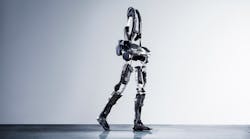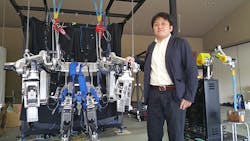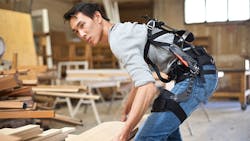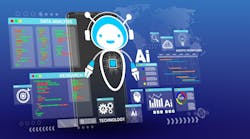Thirty years ago, exoskeletons seemed to be popping up around every corner. Police officer Alex Murphy suited up in one to serve and protect Detroit. Ellen Ripley donned another to lift heavy materials aboard her ship, among other uses. And billionaire Tony Stark was already decades into his own development and use of the technology to help save the world.
Wait. Wait just one second. RoboCop isn’t real. Neither is the Caterpillar P-5000 Work Loader from Alien. Iron Man, despite the best efforts of Elon Musk, is still a fictional character. Exoskeletons really were everywhere back in the 1980s because reality had not yet gained on imagination. We were free to dream anything and suffer no real consequences.
Times have changed, though. Exoskeletons and other power-assist devices are in development all over the world, and for all sorts of purposes — industrial use among them.
“Those movies are great, don’t get me wrong, and they’re entertaining, but we’re not inspired by them,” said Dr. Homayoon Kazerooni, a professor of mechanical engineering at California Berkeley and the father of modern exoskeletons. “No science-fiction movie gives an accurate definition of what scientists are trying to do. They get strong, they run fast, they jump over buildings. It’s difficult to entertain by showing workers who just work a little more efficiently, a little quicker.
“Knowing a worker will move a two-pound drill all day without any shoulder pain, that’s inspiring. That’s huge. Knowing people can fly or drive in an exoskeleton, that’s inspiring. Iron Man, Alien, they’re fun, I’ve seen them all. But they’re just entertainment.”
The wearable robotics industry is projected to develop into a $2 billion global market within the next decade. What can you expect between then and now? And how can you apply this tech to your floor and see real ROI?
A High-Tech Safety Solution
In the Alien films, the aforementioned Power Loader towered above humans, its oversized frame equal parts inspiring and, in the wrong moments or hands, terrifying. Exoskeletons that look like it still garner plenty of attention. Which is why Hiromicho Fujimoto developed his Power Effector.
Fujimoto is the president of ActiveLink, a Panasonic spinoff headquartered beneath a thatched roof in the idyllic Japanese city of Nara, about five hours west of Tokyo. He grew up reading and watching science-fiction, his mind filled with the fantastic. “I wanted to see the world I was reading about come true,” he said. To do that, he joined Panasonic and worked for more than a decade, mostly in motor research. In 2003, he presented to corporate leadership his spinoff idea to develop, produce and sell power-assist suits.
The Power Effector receives more attention than anything else he and his ActiveLink team develop. It represents a front door, of sorts, to the other power-assist devices — PowerLoader Light Ninja leg frames, backpack weight belts, power arm prototypes — that can ease the physical burden endured by workers. That is where all the attention will turn before much longer, Fujimoto said.
According to various research, reports and industry estimates, worker overexertion works out to about $15 billion annually for employers in terms of lost time and workers’ compensation. Who wouldn’t want to turn to tech to curb that figure?
Even lifting a 10- or 15-pound item can be taxing if done repetitively, noted Ed Potoczak, director of industry relations at IQMS. “Doing that over and over again with those kinds of loads tends to create long-term stresses on the body.” He said an exoskeleton may allow a worker to lift more, not to mention more often and more safely.
“When you reduce your injury incidences, your rates tend to go down,” Potoczak said. “So between time away, recuperation and recovery, all that would represent hard savings to an employer.”
Fujimoto, for one, recognized the need to enhance workers on the floor — and to suit them with the tech necessary to work harder and smarter — well before the turn of the century. The leg frames he created are designed more for disaster areas, allowing first responders an easier path through rubble or up steep inclines. But the backpack weight belts alleviate stress from the waist and hips while lifting heavy objects. They’re designed not to make workers stronger, but to ease the burden of tedious or monotonous work. And they seem perfect for factories.
There are drawbacks, of course. ActiveLink and other exoskeleton companies tend to rely heavily on motors, which DARPA reportedly told Fujimoto is not practical. The learning curve for radically new machines can be far longer than most manufacturers are used to, too. And there’s the fact that, like many Japanese companies, ActiveLink plans to roll out everything in Japan first before turning its eyes to the international market. So what’s available a little closer to home?
Lightening the Load for Future Workers
On the other side of the Pacific, Kazerooni — the father of modern exoskeletons who is inspired not by movies, but by real workers whose load is figuratively and literally lightened by such products — is deep at work on the technology that has consumed his life for the last 12 years.
Kazerooni founded Ekso Bionics, among the current leaders in exoskeleton development, back in 2005. He later left the company and, in 2012, founded suitX, which is arguably Ekso’s biggest competitor.
As a university professor and the director of the Berkeley Robotics and Human Engineering Laboratory, he works with some of the brighter young engineering minds, and he turns to them often. Already this century, he has worked with the U.S. military to help develop the Berkeley Lower Extremity Exoskeleton (BLEEX) and the Human Universal Load Carrier (HULC). Now his attention is on introducing affordable exoskeletons to the market for child paraplegics and, of course, industrial workers.
“Part of my work is to educate people and to make sure they have the right stuff,” Kazerooni said. “I’m not trying to sell devices. The industrial work I do, anything I do beyond education and research, is just an extension of a product development. Many, many tasks cannot be automated, but we can take care of the workers and have a better work environment. These are the workers who do unstructured jobs — filling up trucks with boxes, bending, squatting, using their whole bodies.
“We can’t replace the workers; we just give them strength. It lets them work and have less risk of injury.”
According to Kazerooni (pictured below), the new suitX MAX — short for Modular Agile eXoskeleton — can decrease stress by about 50% for payloads of 30 or 40 pounds, and about 40% for payloads of as much as 100 pounds. “If you’re picking up 50 pounds,” Kazerooni said, “this makes it feel like 20 or 25.”
The number of exoskeletons in factories is still incredibly small — suitX has shipped just 55, with 80 ordered — but the potential is tremendous. “You don’t have to be a scientist to predict the next five years,” Kazerooni said. “Just look at the last five years and everything becomes smarter. Every product is rapidly changing, and that’s happening here.”
One of the major talking points that Kazerooni and other exoskeleton leaders want to draw attention to is that not all manufacturing jobs can be, will be, or need to be automated.
“If you think all workers will be robots — that, to me, is not going to happen,” Kazerooni said. “Technologically, we’re far behind where we need to be for that to happen. I’ve never seen any robot on the street, anyway, just in factories. Are they out there to do the work for us? I doubt it. And culturally, we just can’t replace the worker with a robot. The guys who work intelligently in, say, a shipyard, a skilled worker in a factory or a foundry, these are hard jobs to replace.
“We could spend our time and money designing machines that allow us to run faster, to jump higher. But I don’t want to predict the future. I want to work with what we have. Our focus right now is on the workers and on the people who need this for their daily work.”
Military and Industry Interest
And who, exactly, is using exoskeletons today? More than anybody else, the U.S. military, which has worked with suitX and Lockheed Martin, among other companies. Every major carmaker, though none of them want to talk about the whys or hows on the record. Toyota and Honda are both developing power-assist walking devices, with the work happening outside their auto manufacturing departments.
“The companies that are being written about are just going from R&D and prototyping to commercialization, where they’re beginning to deliver some product,” Potoczak said. “Right now, this is along the lines of where Industry 4.0 was two or three years ago: The concepts and the technology were available then, but companies are only beginning to invest seriously now.”
“We’re talking about practical devices for the next four, five years,” Kazerooni said. “The future isn’t here.”
Not yet, at least.







